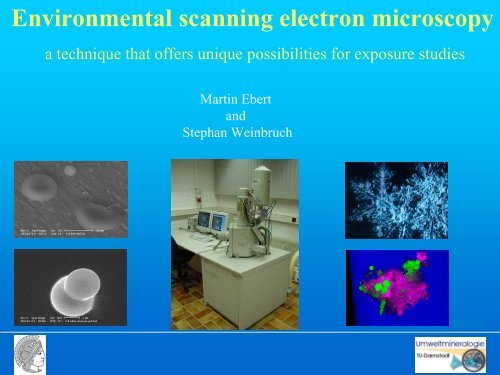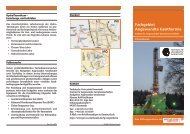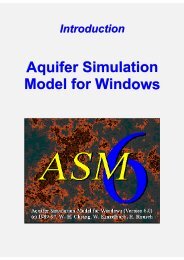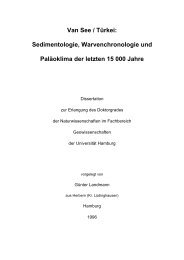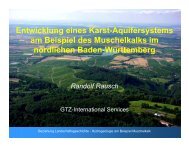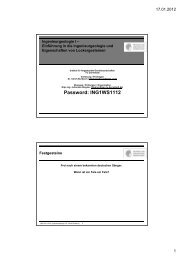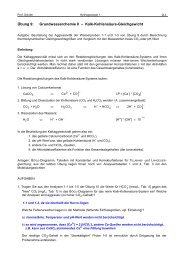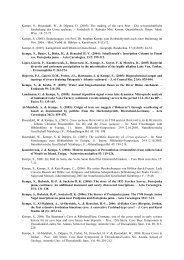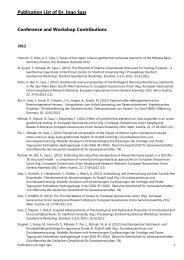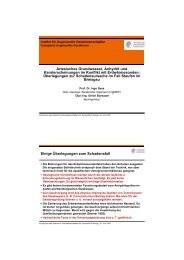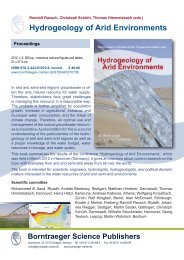Environmental scanning electron microscopy
Environmental scanning electron microscopy
Environmental scanning electron microscopy
Create successful ePaper yourself
Turn your PDF publications into a flip-book with our unique Google optimized e-Paper software.
<strong>Environmental</strong> <strong>scanning</strong> <strong>electron</strong> <strong>microscopy</strong><br />
a technique that offers unique possibilities for exposure studies<br />
Martin Ebert<br />
and<br />
Stephan Weinbruch
CONTENTS<br />
1. Individual Particle Analysis by SEM<br />
2. Basics of <strong>Environmental</strong> Scanning Electron Microscopy (ESEM)<br />
3. ESEM applications in exposure studies
Cabability of Scanning Electron Microscopy<br />
-Excellent resolution (~ 1nm)<br />
-Excellent depth of field<br />
-Chemical element identification by EDX<br />
But all samples in the SEM are exposed to high vacuum<br />
⇒ no volatile or nonconductive samples can be investigated<br />
(without sample preparation)
Why do we need high vacuum in a SEM ?
3. Basics of <strong>Environmental</strong> Scanning Electron Microscopy (ESEM)
Gaseous Secondary Electron Detector (GSE)<br />
• gas molecules are used for<br />
amplification<br />
p contrast <br />
• more gas molecules cause<br />
more scattering<br />
p resolution <br />
best image quality<br />
~4 Torr
Temperature working range in ESEM<br />
Cooling stage<br />
Heating stage 1<br />
Heating stage 2<br />
-30 0 30 60 1000 1500<br />
temperature [°C]
Druck u. Temperatur-Arbeitsbereich im ESEM<br />
Druck in Torr<br />
Der mögliche Druck und<br />
Temperatur-Arbeitsbereich<br />
im Esem ermöglicht die<br />
Untersuchung von Wasser<br />
sowohl im flüssigen als<br />
auch im festen Zustand.
4. ESEM applications in exposure studies<br />
4.1. Characterization of volatile and astable aerosol components<br />
At pressures of 1- 10 mbar most of<br />
the volatile components of the<br />
aerosol can be studied in the ESEM<br />
(sulfates, nitrates, organics, liquid<br />
water).<br />
Secondary <strong>electron</strong> picture<br />
of ammonium nitrate particles<br />
in the ESEM
Characterization of volatile aerosol components<br />
fresh soot in the ESEM<br />
same particle<br />
exposed to high vacuum
Investigation of pollen and spores<br />
a<br />
b<br />
Particles deposited on gelantine covered substrates can directly<br />
be ínvestigated in the ESEM
Investigation of pollen and spores<br />
a b c<br />
Spores bursting and degassing under <strong>electron</strong> bombardement
4.2. Investigation of water containing samples<br />
and interactions with water<br />
soot with solved inclusions<br />
undried or even living biogenic<br />
material (e.g. dermal tissue)<br />
mites
RH = 90%<br />
Activation of unsoluble particles<br />
at high relative humidities<br />
soot<br />
RH = 99%<br />
RH = 100%<br />
increasing<br />
relative humidity<br />
water
Deliquescence and efflorescence<br />
drop formation<br />
recrystallization<br />
RH = 80% RH = 85% RH = 60%<br />
Deliquescence and efflorescence of a sodium sulfate particle
DRH at 25°C determined in the ESEM, compared with the<br />
values obtained by other techniques<br />
85<br />
Na 2<br />
SO 4<br />
DRH [%] at 25°C, this study<br />
80<br />
75<br />
70<br />
65<br />
NH 4<br />
NO 3<br />
NaCl<br />
(NH 4<br />
) 2<br />
SO 4<br />
60<br />
60 65 70 75 80 85<br />
DRH [%] at 25°C, references*<br />
*Ebert et al., 2002
Deliquescence und efflorescence of sodium chloride<br />
RH inc., ESEM, D P<br />
> 100 nm, T = 5° RH dec., Jout. et al., D P<br />
= 100 nm T = 23°C<br />
RH dec., ESEM, D P<br />
> 100 nm, T = 5° RH inc., Hämeri et al., D P<br />
= 50 nm, T = 25°C<br />
RH inc., Jout. et al., D P<br />
= 100 nm, T = 23°C RH dec., Hämeri et al., D P<br />
= 50 nm, T = 25°C<br />
2.5<br />
NaCl<br />
growth factor<br />
2.0<br />
1.5<br />
crystallisation<br />
ESEM<br />
drop<br />
formation<br />
crystallisation<br />
Joutsensaari et al.<br />
1.0<br />
20 30 40 50 60 70 80 90 100<br />
relative humitidy [%]
Deliquescence behavior of Ni-containing particles<br />
b) Partial deliquescence<br />
RH 72 % RH 95 %
4.3. Ice in the ESEM
aerosol particles and ice nucleation in the atmosphere<br />
Homogeneous ice nucleation of a supercooled cloud droplet:<br />
does not start until -38°C !!!<br />
Heterogeneous ice nucleation (induced by special aerosol particles):<br />
was observed already at -5°C !!!<br />
aerosol particles<br />
ice<br />
nuclei<br />
? CCN
sample chamber of the ESEM with cooling stage<br />
SE detector<br />
pole shoe<br />
sample<br />
peltier<br />
cooling<br />
stage<br />
CCD camera<br />
gaseous SE<br />
detector<br />
water<br />
cooling
Heterogeneous ice nucleation in the ESEM<br />
ice<br />
mica<br />
ice<br />
mica<br />
T = - 5°C
4.4. additional devices: Micro manipulator<br />
micromanipulator in ESEM<br />
scratching the surface<br />
drop off or pick up<br />
electrical conducting
micro injector (drop off or pick up solution)
CONTEXT<br />
• Additionally to the capabilities of conventional SEM, ESEM enables<br />
<strong>electron</strong>microscopic analysis at pressures up to 50 Torr (~6700 Pa) and<br />
temperatures between –30 to 1500°C.<br />
• Analysis of non conductive, wet, astable and living material becomes<br />
suitable. This enables a more complete picture of the ambient aerosols.<br />
• Hygroscopic behaviour (e.g. deliquescnece, efflorescence, activation<br />
ice forming prperties..) of particles can be studied in situ.<br />
• No charging effects ⇒ no coating of non-conductive samples.<br />
• Observation of in-situ processes (SE/BSE/EDX).<br />
• The <strong>scanning</strong> <strong>electron</strong> microscope can be used as a reaction<br />
chamber, customized for different requirements (cryo-SEM, micromanipulator,<br />
microinjector, residual gas analysis).


